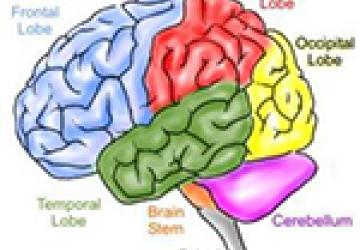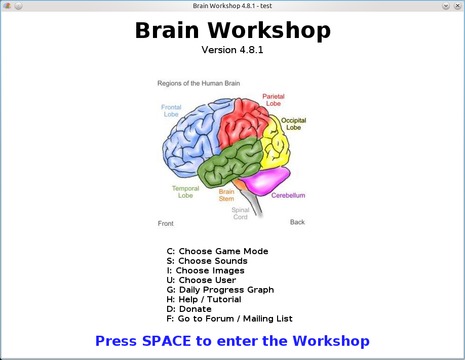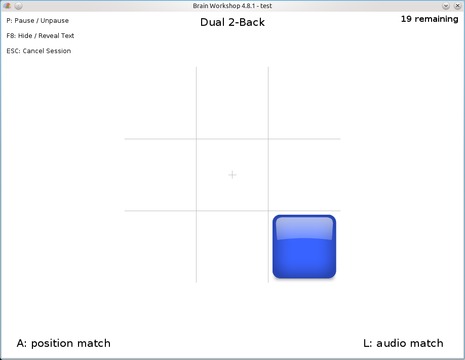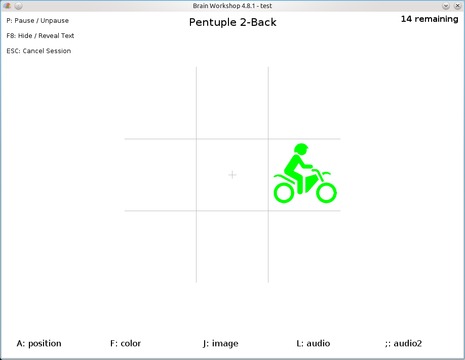Project - Brain Workshop

If you're looking to improve your mental faculties, especially in the area of memory, check out this project. According to the Web site:
Brain Workshop is a free open-source version of the dual n-back brain training exercise.
...A recent study published in PNAS, an important scientific journal, shows that a particular memory task called dual n-back may actually improve working memory (short-term memory) and fluid intelligence.
...Brain Workshop implements this task. The dual n-back task involves remembering a sequence of spoken letters and a sequence of positions of a square at the same time, and identifying when a letter or position matches the one that appeared in trials earlier.

Anatomy students will be chuffed with this brain diagram in the menu background.

The main playing mode involves remembering letters and positions, two turns back.

Some of the advanced playing modes of Brain Workshop include multiple audio streams, images, arithmetic and more.
Installation
Although running Brain Workshop isn't particularly difficult, installing another external program, AVBin 7, is recommended.
Head to the project Web site, click the Download link, and click the link, “Source Distribution for Linux”. This page contains instructions for both Mac OS X and Linux. Scroll down the page for the Linux instructions. The only other real requirement mentioned here is Python 2.5, although most modern distros likely have this pre-installed.
As I mentioned above, the instructions say that you should install AVBin 7. Although this is optional, it will give you musical cues that are rather satisfying, so I recommend doing so. Luckily for me, the Webmaster has been good enough to provide detailed instructions for AVBin's installation, as well as links to both 32- and 64-bit versions.
Once the prerequisites are out of the way, grab the latest tarball and extract it. From here, the Webmaster again has done the work, so I'm quoting the next step verbatim: “Open a terminal, enter the brainworkshop directory and type python brainworkshop.pyw to launch Brain Workshop. You also may enable execute permissions on brainworkshop.pyw, if you'd like to launch it, by double-clicking.”
Usage
Upon entering the program, you'll be greeted with a menu and a fabulous background diagram of an anatomical brain. I could explore a number of options at this point, but for now, let's jump right into the game.
Press the spacebar, and the level that's about to start appears, most likely called Dual 2-Back. Here you can alter the game mode if you know what you're doing. Press the spacebar a second time, and the level actually starts.
Now strap yourself in, because this game is much more grueling than it first appears. Assuming you have the game set to its defaults, two stimuli will be coming at you: positions and audio. The former appears in the guise of a blue square, appearing randomly in any of the nine squares. The latter takes place as letters, spoken out loud by a female voice that just happens to sound like the one used on almost all computer systems in every futuristic sci-fi movie ever made.
As this is happening, you control the game with only two keys: A and L. Let go of the mouse, and let your left hand rest on A and your right hand on L. Now, I'll explain how the game actually works.
Each level has a series of three-second Trials. The first Trial will have the square appear in one of the boxes in tandem with a spoken letter. The second Trial will have the square in another box with another spoken letter. These first two Trials don't require you to do anything, but instead provide the information for the following Trials.
Given this default mode is “2-Back”, the information provided in the first Trial is the basis for testing against in the third Trial. The information in the second Trial is for testing against the fourth, and so on. Now, let's examine the third Trial and onward, where the actual game begins.
Was the position of the blue block the same as the first Trial? If so, press the A key. Was the letter the same? If so, press L. Each Trial may have a combination of both position and letter, or just the one, or even no matches.
As you can see, this game mode is all about remembering what happened two Trials ago. This sounds easy, but each stimulus acts independently of the other, so most of the time, the letter and position won't land in the same place. This means your memory has to split in two different directions—multitasking in memory. Does that sound tricky? Believe me, it is. I'd even go so far as to call it intense.
Chances are you'll get a bad score, but that's okay. The manual recommends starting with a game of 1-Back, but I thought I'd start you off with the harder mode because I'm mean like that! If you want to alter the difficulty, prior to starting a level is a list of options at the top left where you can increase/decrease the N-Back number (try 1 for instance), the number of trials, change the speed and so on.
That's all I have space for here, but if you want more information, check out the game's documentation available at the main menu. I recommend looking into the game's more-advanced features, such as color and image testing, arithmetic and more.
All in all, this is one of the most grueling brain exercises I've come across, and anyone looking to improve specific areas of memory definitely should try Brain Workshop.
Find out more at brainworkshop.sourceforge.net










